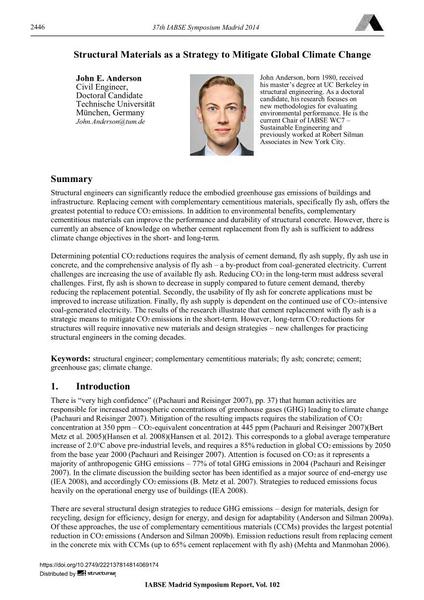Structural Materials as a Strategy to Mitigate Global Climate Change

|
|
|||||||||||
Bibliografische Angaben
| Autor(en): |
John E. Anderson
|
||||
|---|---|---|---|---|---|
| Medium: | Tagungsbeitrag | ||||
| Sprache(n): | Englisch | ||||
| Tagung: | IABSE Symposium: Engineering for Progress, Nature and People, Madrid, Spain, 3-5 September 2014 | ||||
| Veröffentlicht in: | IABSE Symposium Madrid 2014 | ||||
|
|||||
| Seite(n): | 2446-2453 | ||||
| Anzahl der Seiten (im PDF): | 8 | ||||
| Jahr: | 2014 | ||||
| DOI: | 10.2749/222137814814069174 | ||||
| Abstrakt: |
Structural engineers can significantly reduce the embodied greenhouse gas emissions of buildings and infrastructure. Replacing cement with complementary cementitious materials, specifically fly ash, offers the greatest potential to reduce CO2 emissions. In addition to environmental benefits, complementary cementitious materials can improve the performance and durability of structural concrete. However, there is currently an absence of knowledge on whether cement replacement from fly ash is sufficient to address climate change objectives in the short- and long-term. Determining potential CO2 reductions requires the analysis of cement demand, fly ash supply, fly ash use in concrete, and the comprehensive analysis of fly ash – a by-product from coal-generated electricity. Current challenges are increasing the use of available fly ash. Reducing CO2 in the long-term must address several challenges. First, fly ash is shown to decrease in supply compared to future cement demand, thereby reducing the replacement potential. Secondly, the usability of fly ash for concrete applications must be improved to increase utilization. Finally, fly ash supply is dependent on the continued use of CO2-intensive coal-generated electricity. The results of the research illustrate that cement replacement with fly ash is a strategic means to mitigate CO2 emissions in the short-term. However, long-term CO2 reductions for structures will require innovative new materials and design strategies – new challenges for practicing structural engineers in the coming decades. |
||||
| Stichwörter: |
Beton Bauingenieur Zement
|
||||
